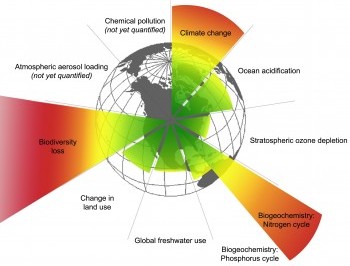
Kirsty Schneeberger in her latest blog discussed planetary boundaries and I know that many of us were fascinated by this simple yet completely logical concept, even for a non scientist. Here I wish to further the analysis but first off to say that Peter Roderick is taking forward this idea in the UK in various ways and that I hope that we will hear from him on the site in the not too distant future.
The concept of planetary boundaries is a scientific one – there are certain limits or boundaries within our Earth Systems that if not respected can cause “catastrophic environmental change at continental to global scales”. Johan Rockström of the Stockholm Resilience Centrehas pioneered estimating boundaries for the biophysical processes that “determine the Earth’s capacity for self-regulation”.
Using existing data, Rockström and colleagues put ‘acceptable’ upper limits on seven environmental factors: climate change, freshwater use, ocean acidification, and stratospheric ozone depletion, biodiversity loss, the global cycles of nitrogen and phosphorus, and land-use change. We are told that crossing even one of these limits can risk irreversible environmental changes. And if one boundary is transgressed, then others are at serious risk of being breached. We have already passed three of the nine suggested thresholds – climate change, biodiversity and the nitrogen cycle. Exactly where are we heading?
The idea of planetary boundaries is very much in line with the Gaia Theory, Earth Jurisprudence and Earth Rights’ theories which requires humans to act in harmony within the limits of the laws of nature for our survival on this self regulating planet. The campaign for the rights of future generations is also linked with biophysical realities of non-deniable limits which will determine whether there is such a thing as human future generations.
Peter has linked planetary boundaries with sustainable development. Sustainability would still be formed of the three pillars of economy, society and environment but when it comes to balancing the three, the weight is measured against the backdrop of the non-negotiable limits provided by each of the planetary boundaries.
The idea of planetary boundaries has already been taken up by the Secretary-General’s High-Level Panel on Global Sustainability: the overall goal for its report later this year and input intoRio+20 is “To eradicate poverty and reduce inequality, make growth inclusive, and production and consumption more sustainable while combating climate change and respecting the range of other planetary boundaries.” The UK’s Institution of Civil Engineers has said that “the concept is clear and sufficiently intuitive that we can begin to explore ways in which society can stay within such boundaries.”
Perhaps we could equate planetary boundaries with the public interest when discussing sustainability or incorporate it as a legal principle on which we base our policies. If we are able to integrate this concept into our decision making we may understand the safe limits in which society can operate in order to avoid disaster.
Image taken from Rockström et al. Nature (2009) and Ida Kubiszewski/Solutions.







